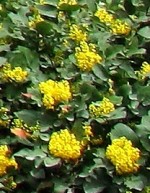 This low growing suckering evergreen shrub is native to northwest America from British Columbia and Alberta to Arizona and New Mexico and west to California. The shiny blue-green leaves are up to ten inches long and pinnately compound usually consisting of five holly-like leaflets that are very spiny and have small protrubances on their underside. In cold weather the leaves turn purplish or bronze. The fragrant yellow flowers are produced in spring on three inch long racemes and give way to clusters of small purple berries in late summer. Plants sucker freely and can produce a substantial clump. They grow about eight to twenty four inches high, make an excellent ground cover, and are especially useful for erosion control. Creeping mahonia hybridizes easily with Oregon grape (Mahonia aquifolium) so many intermediate plants may arise where both plants are present.
This low growing suckering evergreen shrub is native to northwest America from British Columbia and Alberta to Arizona and New Mexico and west to California. The shiny blue-green leaves are up to ten inches long and pinnately compound usually consisting of five holly-like leaflets that are very spiny and have small protrubances on their underside. In cold weather the leaves turn purplish or bronze. The fragrant yellow flowers are produced in spring on three inch long racemes and give way to clusters of small purple berries in late summer. Plants sucker freely and can produce a substantial clump. They grow about eight to twenty four inches high, make an excellent ground cover, and are especially useful for erosion control. Creeping mahonia hybridizes easily with Oregon grape (Mahonia aquifolium) so many intermediate plants may arise where both plants are present.
Type: Flowering evergreen shrub
Outstanding Features: Foliage, flowers
Form: Low frowing, climp-forming
Growth Rate: Moderate
Bloom: Fragrant yellow flowers are produced in 1-3″ racemes i spring followed by purple berries in late summer.
Size: 18-24″ H x 3-4′ W
Light: Full sun to partial shade but needs protection from drying winds in winter.
Soil: Average, medium-moist, well-drained, acidic; drought tolerant once established
Hardiness:Zones 5-8
Care:Medium maintenance
Pests and Diseases: Susceptible to rust, leaf spot, scale, aphids, whiteflies
Propagation: Cuttings, division of rooted suckers
Outstanding Selection: ‘Denver Stain’
